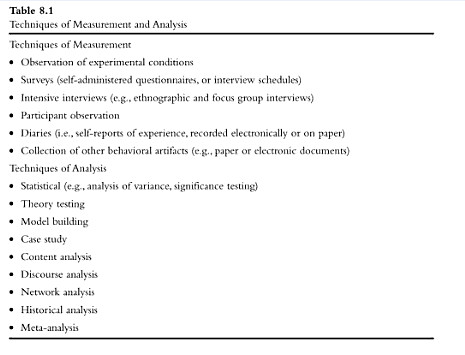Chapter 8: the Research Process
Abstract:
Chapter 8 discusses the nuts and bolts of designing research. It is a tad academic, but its argument is compelling. Case asserts that one should use techniques for measuring and observing to minimize human interpretative error and allow us to compare results across a common foundation.
He notes common sources of human error:
- poor observational skills
- tendency to overgeneralize from small samples
- tendency to make up information to support our beliefs
- ego and defensiveness
- prejudice
- tendency to assume we can't explain complex issues
His table on page 177 gives a helpful overview of techniques for measurement (collecting data), as opposed to those for analysis of data.

Next, Case outlines the 5 stages in the research process:
- Conceptualization: where research questions are formed
- Study design: a plan for exploring the question via research, involves defining the data sought
- Technique application: if possible, multiple sources of data is more convincing*
- Analysis & Interpretation of data collected
- Summarization & Conclusions
Case briefly explains the difference between the inductive and deductive approaches, most researchers use both.
- Inductive starts with a specific case and attempts to create a general principle or theory.
- Deductive starts with a general theory or principle and tests it scientifically.
For those testing a deductive theory, it is particularly important to: define their research problem and hypotheses, operationationalize their objects, and create an observational definition to guide the study's observation.
Regardless of your approach, its believability will largely rest on its validity and reliability. It is valid if your procedures for measurement are accurate representations of what you're studying. It is reliable if you get the same results when the study is repeated. It's hard to be both highly reliable and highly valid. Much of the argument that favors quantitative (number-based) research is questionable valid because of its artificial, lab conditions. On the other hand, a qualitative bit of research can be hard to repeat.
Before selecting a method to use in research, one should consider your study's:
- Purpose: is your goal to:
- explore
- describe
- explain?
- Units of analysis: what will you be observing?
- people (either individually or in groups) or
- artifacts (objects or events)
- Time: when will you do your research?
- cross-sectional: all your research is at one point in time
- longitudinal: your measurements will be made over several points in time
Finally, with a brief note about the difficulties and importance of following some of these in an internet setting, Case gives 4 general ethical guidelines for research studies:
- No harm should come to participants in a study
- Study participants should not be deceived or misled in any way
- Participation in an investigation should be voluntary
- Any data collected about Individuals should be confidential
On inductive methods: A usability study, for instance, is likely to take a few specific people attempting tasks on one website and attempt to generalize or explain any problems they have. As Case recommends, you can combine methods - using Morae to capture quantitative data such as completion time and rate, but using qualitative comments to help in the analysis phase. In usability, the longitudinal time consideration is particularly important: one must benchmark the before and after of any redesign to demonstrate ROI and gain institutional support for UX and IA design work.
Chapter 9: Method Types
Abstract: Case outlines and gives examples of the various methods used for HIB research, which include:
- case study
- lab experiments
- field experiments
- postal surveys
- email and Web surveys
- brief interviews
- intensive interviews
- focus group interviews
- network analysis
- discourse analysis
- diaries and experience sampling
- historical analysis (unobtrusive)
- content analysis (unobtrusive)
- using multiple data sources in a single investigation
- meta-analysis
He notes that surveys (and interviews) are the most frequently used type of method in information science. For email/Web survey methods, for which Case notes the following problems:
- difficulty of establishing relevance to users
- can seem impersonal
- can bias the sample toward those with Internet access and technological skills
- technology can make calculating sample size and response rate difficult
- harder to capture the complexity and context that more observational/interview methods do
However, email/Web surveys don't require much typing and are easier to use/complete, which can increase the user response rate and lower the developer's time and effort.
Case's chapter is an excellent orientation to each method, but for a better sense of any particular method, one will need to look elsewhere. Also check out Wilson (2007); This was surprising: "observation as a method is not covered...it is a standard ethnographic method and, perhaps, ought to be more used in field investigations."
For electronic surveys: Dillman (2009) tailored design approach to online surveys; focuses on increasing the benefits and decreasing the costs of responding for participants, as well as establishing trust. The summary tables on pages 35 and 38 are an excellent cheat sheet to this approach. Examples of how to operationalize these foci are:
- Establish trust:
- sponsorship from a worthy organization
- promote the importance of the survey's task in the opening page
- ensure confidentiality by asking for few traditionally identifying details about participants
- Reduce participant cost:
- use non-subordinating language
- essential questions only
- question sequence: increase interest at start; promote overall ease in its use.
- Increase survey benefits for participants:
- brief description of the survey's purpose on the opening page
- respectfully ask for help
- express appreciation both in advance and at the end of the survey
Good free, opensource software option: Limesurvey.
Tthoughts from practitioners of user research:
- User research topic on UXmatters
- Methods topic on boxes and arrows
Bibliography
Case, D. (2008). Looking for information: A survey of research on information seeking, needs, and behaviors, 2nd Edition. Emerald Group Publishing Limited. ISBN: 978-0123694300.
Dillman, D. A., Smyth, J. D., & Christian, L. M. (2009). Internet, mail, and mixed mode surveys: The tailored design method. Hoboken, N.J.: Wiley & Sons. ISBN: 978-0471698685.
